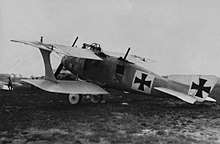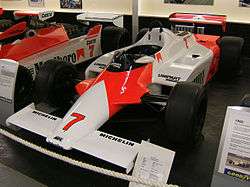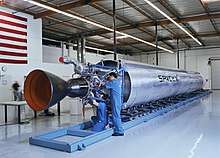Monocoque
Monocoque (/ˈmɒnəˌkɒk, -ˌkoʊk/), also called structural skin, is a structural system in which loads are supported by an object's external skin, similar to an egg shell. The word monocoque is a French term for "single shell" or (of boats) "single hull".[1]
First used for boats,[2] a true monocoque carries both tensile and compressive forces within the skin and can be recognised by the absence of a load-carrying internal frame. Few metal aircraft can strictly be regarded as pure monocoques, as they use a metal shell or sheeting reinforced with frames riveted to the skin, but most wooden aircraft are described as monocoques, even though they also incorporate frames.
By contrast, a semi-monocoque is a hybrid combining a tensile stressed skin and a compressive structure made up of longerons and ribs or frames.[3] Other semi-monocoques, not to be confused with true monocoques, include vehicle unibodies, which tend to be composites, and inflatable shells or balloon tanks, both of which are pressure stabilised.
Aircraft

_D.I.jpg)
Early aircraft were constructed using frames, typically of wood or steel tubing, which could then be covered (or skinned) with fabric[4] such as Irish linen or cotton.[5] The fabric made a minor structural contribution in tension but none in compression and was there for aerodynamic reasons only. By considering the structure as a whole and not just the sum of its parts, monocoque construction integrated the skin and frame into a single load-bearing shell with significant improvements to strength and weight.
To make the shell, thin strips of wood were laminated into a three dimensional shape; a technique adopted from boat hull construction. One of the earliest examples was the Deperdussin Monocoque racer in 1912, which used a laminated fuselage made up of three layers of glued poplar veneer, which provided both the external skin and the main load-bearing structure.[6] This also produced a smoother surface and reduced drag so effectively that it was able to win most of the races it was entered into.[6]
This style of construction was further developed in Germany by LFG Roland using the patented Wickelrumpf (wrapped body) form later licensed by them to Pfalz Flugzeugwerke who used it on several fighter aircraft. Each half of the fuselage shell was formed over a male mold using two layers of plywood strips with fabric wrapping between them. The early plywood used was prone to damage from moisture and delamination.[7]
While all-metal aircraft such as the Junkers J 1 had appeared as early as 1915, these were not monocoques but added a metal skin to an underlying framework.
The first metal monocoques were built by Claudius Dornier, while working for Zeppelin-Lindau.[8] He had to overcome a number of problems, not least was the quality of aluminium alloys strong enough to use as structural materials, which frequently formed layers instead of presenting a uniform material.[8] After failed attempts with several large flying boats in which a few components were monocoques, he built the Zeppelin-Lindau V1 to test out a monocoque fuselage. Although it crashed, he learned a lot from its construction. The Dornier-Zeppelin D.I was built in 1918 and although too late for operational service during the war was the first all metal monocoque aircraft to enter production.[8][9]
In parallel to Dornier, Zeppelin also employed Adolf Rohrbach, who built the Zeppelin-Staaken E-4/20, which when it flew in 1920[10] became the first multi-engined monocoque airliner, before being destroyed under orders of the Inter-Allied Commission. At the end of WWI, the Inter-Allied Technical Commission published details of the last Zeppelin-Lindau flying boat showing its monocoque construction. In the UK, Oswald Short built a number of experimental aircraft with metal monocoque fuselages starting with the 1920 Short Silver Streak in an attempt to convince the air ministry of its superiority over wood. Despite advantages, aluminium alloy monocoques would not become common until the mid 1930s as a result of a number of factors, including design conservatism and production setup costs. Short would eventually prove the merits of the construction method with a series of flying boats, whose metal hulls didn't absorb water as the wooden hulls did, greatly improving performance. In the United States, Northrop was a major pioneer, introducing techniques used by his own company and Douglas with the Northrop Alpha.
Road vehicles

In motor racing, the safety of the driver depends on the car body, which must meet stringent regulations, and only a few cars have been built with monocoque structures.[11][12] An aluminum alloy monocoque chassis was first used in the 1962 Lotus 25 Formula 1 race car and McLaren was the first to use carbon-fiber-reinforced polymers to construct the monocoque of the 1981 McLaren MP4/1. In 1990 the Jaguar XJR 15 became the first production car with a carbon-fiber monocoque.[13]
The term monocoque is frequently misapplied to unibody cars. Commercial car bodies are almost never true monocoques but instead use the unibody system (also referred to as unitary construction, unitary body–chassis or body–frame integral construction),[14] which uses box sections, bulkheads and tubes to provide most of the strength of the vehicle, while the skin adds relatively little strength or stiffness.[15]
Armoured vehicles
Some armoured fighting vehicles use a monocoque structure with a body shell built up from armour plates, rather than attaching them to a frame. This reduces weight for a given amount of armour. Examples include the German TPz Fuchs and RG-33.
Two-wheeled vehicles
French industrialist and engineer Georges Roy attempted in the 1920s to improve on the bicycle-inspired motorcycle frames of the day, which lacked rigidity. This limited their handling and therefore performance. He applied for a patent in 1926, and at the 1929 Paris Automotive Show unveiled his new motorcycle, the Art-Deco styled 1930 Majestic. Its new type of monocoque body solved the problems he had addressed, and along with better rigidity it did double-duty, as frame and bodywork provided some protection from the elements. Strictly considered, it was more of a semi-monocoque, as it used a box-section, pressed-steel frame with twin side rails riveted together via crossmembers, along with floor pans and rear and front bulkheads.[2]
A Piatti light scooter was produced in the 1950s using a monocoque hollow shell of sheet-steel pressings welded together, into which the engine and transmission were installed from underneath. The machine could be tipped onto its side, resting on the bolt-on footboards for mechanical access.[16]
A monocoque-framed motorcycle was developed by Spanish manufacturer Ossa for the 1967 Grand Prix motorcycle racing season.[17] Although the single-cylinder Ossa had 20 horsepower (15 kW) less than its rivals, it was 45 pounds (20 kg) lighter and its monocoque frame was much stiffer than conventional motorcycle frames, giving it superior agility on the racetrack.[17] Ossa won four Grands Prix races with the monocoque bike before their rider died after a crash during the 250 cc event at the 1970 Isle of Man TT, causing the Ossa factory to withdraw from Grand Prix competition.[17]
Notable designers such as Eric Offenstadt and Dan Hanebrink created unique monocoque designs for racing in the early 1970s.[18] The F750 event at the 1973 Isle of Man TT races was won by Peter Williams on the monocoque-framed John Player Special that he helped to design based on Norton Commando.[19][20] Honda also experimented with the NR500, a monocoque Grand Prix racing motorcycle in 1979.[21] The bike had other innovative features, including an engine with oval shaped cylinders, and eventually succumbed to the problems associated with attempting to develop too many new technologies at once. In 1987 John Britten developed the Aero-D One, featuring a composite monocoque chassis that weighed only 12 kg (26 lb).[22]
An aluminium monocoque frame was used for the first time on a mass-produced motorcycle from 2000 on Kawasaki's ZX-12R,[23] their flagship production sportbike aimed at being the fastest production motorcycle. It was described by Cycle World in 2000 as a "monocoque backbone...a single large diameter beam" and "Fabricated from a combination of castings and sheet-metal stampings".[24]
Single-piece carbon fiber bicycle frames are sometimes described as monocoques; however as most use components to form a frame structure (even if molded in a single piece),[25] these are frames not monocoques, and the pedal-cycle industry continues to refer to them as framesets.
Rockets

Various rockets have used pressure-stabilized monocoque designs, such as Atlas[26] and Falcon 1.[27] The Atlas was very light since a major portion of its structural support was provided by its single-wall steel balloon fuel tanks, which hold their shape while under acceleration by internal pressure. Balloon tanks are not true monocoques but act in the same way as inflatable shells. A balloon tank skin only handles tensile forces while compression is resisted by internal liquid pressure in a way similar to semi-monocoques braced by a solid frame. This becomes obvious when internal pressure is lost and the structure collapses.
See also
References
Citations
- Merriam-Webster Dictionary, 2011
- Garson, Paul (May–June 2018). "Art Deco on Wheels: 1930 Majestic". Motorcycle Classics. Retrieved October 6, 2018.CS1 maint: date format (link)
- Airframe and Powerplant Mechanics Airframe Handbook (Publication AC65-15A). Washington, DC: US Department of Transportation Federal Aviation Administration Standards Division. 1976. p. 4. ISBN 0-16-036209-1.
- Megson, 1972, p.198
- Robertson, 1996, pp.1–2
- Aeronautics, 1912, p.112
- FAA, 2001, p.1.2
- Terry, 1981, pp.97–117
- Grosz, 1998
- Haddow, Grosz, 1988 pp. 289–293
- Monocoque – Survival Cell, Technical F1 dictionary
- Passive car safety, Steven De Groote, 26 Mar 2006
- "1991 Jaguar XJR-15".
- NAAA Structural Damage Policy dated 1 January 2011, retrieved 29 March 2012
- Allan, Rob. The Killeen Cars Accessdate:October 2014
- The Motor Cycle, two-page road test, 7 March 1957, pp.298-299. Accessed 15 June 2019
- Robinson, James (September 2001). "Santiago Herrero – Spanish Flyer". Classic Racer (91): 35–40. ISSN 1470-4463.
- "8W – Who? – Eric Offenstadt". Forix.autosport.com. Retrieved 2010-10-20.
- F750 race result iomtt.com. Retrieved 27 December 2019
- "Motorcycle Technology – Future Perfect – Up To Speed". motorcyclistonline.com. Retrieved 17 December 2011.
- "The Unconventional: Adopting a "Shrimp Shell" Frame". Challenging Spirits of Honda. Honda Motor Co., Ltd. Retrieved 2009-12-26.
- "The Aero Bike". Britten Motorcycle Company. Archived from the original on 2009-06-15. Retrieved 2009-06-19.
- "Kawasaki Technology". Kawasaki Heavy Industries Motorcycle & Engine. Archived from the original on January 12, 2017. Retrieved December 18, 2016.
- Anderson, Steve (January 2000). "MEAN GREENIES". Cycle World. p. 34. Retrieved 27 December 2019.
- "Carbon Fiber". Archived from the original on February 24, 2013. Retrieved February 16, 2013., Velocite-bikes.com
- Wade, Mark. "Encyclopedia Astronautica – Atlas". Retrieved 14 November 2011.
- Wade, Mark. "Encyclopedia Astronautica – Falcon 1". Archived from the original on 11 November 2011. Retrieved 14 November 2011.
Bibliography
- Grosz, Peter (1998). Dornier D.I. Windsock Mini datafile # 12. Hertfordshire, UK: Albatros Publications. ISBN 9780948414923.
- Haddow, G.W.; Grosz, Peter M. (1988). The German Giants - The German R-Planes 1914-1918 (third ed.). London: Putnam. pp. 289–293. ISBN 0851778127..
- Megson, T.H.G. (1972). Aircraft Structures for Engineering Students. London: Edward Arnold Publishers LTD. ISBN 0-7131-3393-7.
- Robertson, Bruce (1996). WWI British Aeroplane Colours and Markings. Berkhampstead: Albatros Publications Inc. pp. 1–2. ISBN 0-948414-65-0.
- "Monococque definition". Merriam-Webster Dictionary. Encyclopædia Britannica. 26 September 2011.
- Schatzberg, Eric (1999). Wings of Wood, Wings of Metal: Culture and Technical Choice in American Airplane Materials, 1914–1945. Princeton, N.J.: Princeton University Press. ISBN 978-0691087733.
- Terry, Gerard (1981). "The Development of Dornier Landplanes 1914–1918". Cross & Cockade Great Britain Journal. Society of WW1 Aero Historians. 12 (3): 97–117.
- Acceptable Methods, Techniques, and Practices – Aircraft Inspection and Repair (Publication AC 43.13-1B). Washington, DC: US Department of Transportation Federal Aviation Administration Standards Division. 2001. p. 1.2. ISBN 0-16-036209-1.
- Unknown (1912). "unknown". Aeronautics (October): 112.
| Wikimedia Commons has media related to Monocoques. |